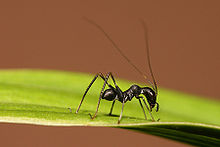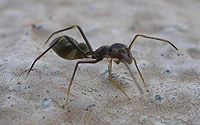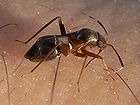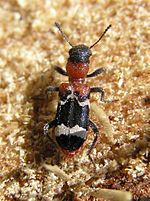- Ant mimicry
-
Ant mimicry is mimicry of ants by other organisms. Ants are abundant all over the world, and insect predators that rely on vision to identify their prey such as birds and wasps normally avoid them, either because they are unpalatable, or aggressive. Thus some other arthropods mimic ants to escape predation (protective mimicry). Conversely, some species (e.g. Zodariidae spiders) use their anatomical and behavioral ant mimicry to hunt ants (aggressive mimicry). Other cases are also known.[1] The term myrmecomorphy is also used to describe ant mimicry.
Contents
By taxa
Spiders
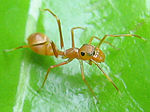 A female Myrmarachne plataleoides in Thailand mimics an Asian weaver ant (Oecophylla smaragdina) worker
A female Myrmarachne plataleoides in Thailand mimics an Asian weaver ant (Oecophylla smaragdina) worker
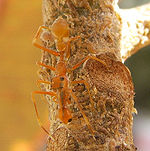 A male Myrmarachne plataleoides spider in Thailand mimics a weaver ant worker carrying another worker
A male Myrmarachne plataleoides spider in Thailand mimics a weaver ant worker carrying another worker
80% of spiders with Batesian mimicry imitate ants, comprising more than 100 species. Ant-mimicking spiders can be found in the following spider families:
- Araneidae (e.g. Micrathena)
- Corinnidae (e.g. Apochinoma, Castianeira, Myrmecium, Corinna vertebrata, Mazax pax, M. spinosa, Myrmecotypus, Sphecotypus, Otacilia, Phrurolithus)
- Dysderidae (Harpactea hombergi preys on ants, behavioral mimic, not morphological)
- Eresidae (Seothyra schreineri males mimic small Camponotus castes)
- Gnaphosidae (e.g. Micaria, Callilepis nocturna)
- Prodidomidae (Myandra)
- Linyphiidae (Linyphia furtiva, Meioneta beata)
- Oonopidae (Diblemma donisthorpei mimics Wasmannia auropunctata)
- Salticidae (e.g. Agorius, Augustaea, Belippo, Bocus, Chalcolecta, Consingis, Corcovetella, Cosmophasis, Depreissia, Eburneana, Enoplomischus, Judalana, Kima, Leptorchestes, Martella, Marengo, Mexcala, Myrmarachne, Paradamoetas cara, Peckhamia picata, Philates, Sadies, Sarinda, Synageles, Synagelides, Synemosyna, Tutelina, Ugandinella, Uluella, Zuniga)
- Theridiidae (e.g. Anatea formicaria, Cerocida strigosa, Coleosoma floridanum (only males), Coleosoma acutiventer, Helvibis brasiliana, H. chilensis, Heleosoma floridanum, Melychiopharis cynips, Cerocida strigosa)
- Thomisidae (e.g. Amyciaea, Aphantochilus, Bucranium, Strophius nigricans)
- Zodariidae (e.g. Storena, Zodarion)
Some spiders (e.g. Zodariidae or some Myrmarachne) use their ant disguise to hunt ants, although most use their disguise to escape predators. In salticids, the latter can be discerned from the ants from the movements they make in order to keep the ants at an acceptable distance. Ant hunters often do not resemble ants as much.[2]
Myrmarachne assimilis is the only Myrmarachne species that resembles the aggressive weaver ant Oecophylla smaragdina, with which it lives in close contact. Cosmophasis bitaeniata uses chemical mimicry to be accepted by the same ant species. It is suggested that M. assimilis uses a similar technique. Thus, its ant mimicry is twofold: in visual appearance to trick predators, but also to evade being hunted by the ants themselves.[3]
Several spiders (eg., most Myrmarachne) undergo transformational mimicry: because the spiderlings are too minute to convincingly mimic the much bigger ant species that the adult copies, they use other smaller ant species as a model.
The overall body of spider myrmecomorphs is much narrower than non-mimics, which reduces the number of eggs per eggsac, compared to non-mimetic spiders of similar size. They seem to compensate by laying more eggsacs in their lifetime.[4] Ant-mimics usually use their first or second pair of legs to fake ant antennae, such reducing the number of functional legs to six.
Sometimes, the sexes each mimic a different model. There are also spiders where several morphs occur, each mimicking a different morph of the model ant species, or different ant species. For example, light yellow to brown morphs of Synemosyna aurantiaca mimic Pseudomyrmex flavidulus and P. oculatus, while black morphs mimic P. gracilis and P. sericeus.
In Micrathena, only males and juveniles resemble ants. This may be mimesis rather than mimicry.
Even within a closely related group of taxa ant mimicry might have originated several times independently. This is demonstrated in the Salticidae subfamily Ballinae.[5]
Mites
The phoretic mite Planodiscus attaches itself to the tibia of its host Eciton hamatum. The cuticula sculpturing of the mite's body is nearly identical to that of the ant's leg.
Hemiptera
Among the bugs, the wingless Myrmecoris gracilis looks like an ant and feeds on ant larvae. Pithanus maerkeli is also ant-like. Systellonotus triguttatus, in which nymphs and females strongly resemble ants, is often found in the vicinity of ants. Dulichius inflatus (Alydidae) closely resembles ants of the genus Polyrhachis.
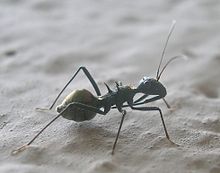 Dulichius inflatus an Alydid bug
Dulichius inflatus an Alydid bug
Pithanus maerkeli roughly resembles an ant, as does the lively Pilophorus perplexus.[6]
The nymph of Himacerus mirmicoides looks like an ant.[7]
Thrips
Franklinothrips is a genus of thrips that is predatory. Especially the females mimic ants in appearance and behavior. Ant mimicry also occurs in other genera of Aeolothripidae, where it has arisen independently, for example Aeolothrips albicinctus in Europe and A. bicolor in North America, the Australian species Desmothrips reedi, Allelothrips with seven species from Africa and India, Stomatothrips with eight species from the Americas. This kind of mimicry probably evolved as a response to the presence of ants.[8]
Phasmids
Extatosoma tiaratum, while resembling dried thorny leaves as an adult, hatches from the egg as a replica of a Leptomyrmex ant, with a red head and black body. The long end is curled to make the body shape appear ant-like, and the movement is erratic, while the adults move differently, if at all. In some species the eggs resemble plant seeds, complete with a mimic elaiosome (called a "capitulum") as in plants that are associated with ants in myrmecochory. These eggs are collected by the ants and taken to their nests. The capitulum is removed and eaten and the eggs continue to be viable.[9]
Mantids
While praying mantids are carnivorous insects, they also are in danger of being eaten by larger animals. The nymphs of the Ghost mantis, Phyllocrania paradoxa, looks like a black ant to repel predators. In later instars, it gets a brownish color and looks like a leaf. Mantids of the genus Creobroter use ant mimicry when young as well.
Diptera
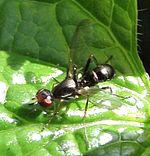 Unidentified fly (Sepsidae) ant mimic from Germany
Unidentified fly (Sepsidae) ant mimic from Germany
There are several fly species that look like an ant.
At least one species from the little studied Richardiidae genus Sepsisoma mimic ants, particularly the formicine ant Camponotus crassus.[10]
Several species of Micropezidae (stilt-legged flies) resemble ants (especially the wingless, haltere-less Badisis ambulans), as do species in the genus Strongylophthalmyia and Syringogaster.
Beetles
Many parasitic Staphylinidae that march with army ants strikingly resemble their hosts. An outstanding example is Ecitomorpha nevermanni, whose color varies to match the color variation of its host Eciton burchellii. Since Eciton army ants have poor vision, this is probably an example of Batesian mimicry to escape predation by vertebrates.
The Anthicidae are also ant-like in appearance.
Members of the cerambycid genus Euderces are ant mimics. E. velutinus mimics Camponotus sericeiventris. Several other cerambycids also resemble ants. The Central American Mallocera spinicollis Bates, 1872, Neoclytus and Diphyrama singularis Bates, 1872 all closely resemble stinging ants. Pseudomyrmecion ramalium Bedel, 1885 closely resembles Crematogaster scutellaris in size and coloration and leaves in close vicinity to it. In North America certain Anthoboscus, Cyrtophorus and Tillomorpha are ant mimics. Cyrtinus pygmaeus resembles Lasius niger americanus, and Michthisoma heterodoxum mimics small workers of Camponotus pennsylvanicus.[11][12] The ant beetle Thanasimus formicarius (Cleridae) mimics ants of the genus Formica.
Coatonachthodes ovambolandicus is a termite-mimicking beetle which lives as a parasite in their nests.
Collemboles
Several species of springtails look like ants, with white lines acting as pseudo-incisions.[citation needed]
Footnotes
- ^ Pasteur, Georges (1982). “A classificatory review of mimicry systems”. Annual Review of Ecology and Systematics 13: 169–199.
- ^ Murphy & Murphy 2000: 303
- ^ Nelson et al. 2006
- ^ Cushing, P. E. C. 1996. Myrmecomorphy and myrmecophily in spiders: a review. Florida Entomologist. 80(2):16-193 [1]
- ^ Benjamin 2004
- ^ Picture of P. perplexus, which has transverse stripes to mimick the body form of an ant.
- ^ Pictures of H. mirmicoides
- ^ Mound & Renaud 2005
- ^ Compton, S. G. and A.B. Ware. (1991) Ants disperse the elaisosome-bearing eggs of an African stick insect. Psyche 98:207-214.
- ^ Pie & Del-Claro 2002
- ^ Wheeler 1931
- ^ Monne & Hovore 2005
References
- Cushing, P.E. (1997): Myrmecomorphy and myrmecophily in spiders: a review. Fla. Entomol. 80: 165–193. PDF
- Komárek, S. (1998): Mimicry, aposematism and related phenomena in animals and plants - a bibliography 1800-1990. Prague: Vesmír.
- Murphy, Frances & Murphy, John (2000): An Introduction to the Spiders of South East Asia. Malaysian Nature Society, Kuala Lumpur.
- Pie, Marcio R. & Del-Claro, Kleber (2002): Male-Male Agonistic Behavior and Ant-Mimicry in a Neotropical Richardiid (Diptera: Richardiidae). Studies on Neotropical Fauna and Environment 37(1): 19-22. doi:10.1076/snfe.37.1.19.2114 PDF
- Benjamin, S.P. (2004): A taxonomic revision and a phylogenetic hypothesis for the jumping spider subfamily Ballinae (Araneae, Salticidae). Zoological Journal of the Linnean Society 142: 1-82. Abstract + PDF
- Mound, L.A. & Reynaud, P. (2005): Franklinothrips; a pantropical Thysanoptera genus of ant-mimicking obligate predators (Aeolothripidae). Zootaxa 864: 1-16. PDF
- Nelson, X.J., Jackson, R.R., Edwards, G.B. & Barrion, A.T. (2006): Living with the enemy: jumping spiders that mimic weaver ants. The Journal of Arachnology 33: 813-819. PDF (Myrmarachne assimilis)
External links
Classification TaxonomyInsecta · Plantae · VertebrataModalityChemical · AuditoryBatesian · Müllerian · Mertensian · Automimicry · Pseudocopulation · Sexual · Vavilovian · Eyespots · Aggressive
Related topics Antipredator adaptation · Animal communication · Aposematism · Camouflage/Crypsis · Co-evolution · Animal coloration · Community ecology · Evolution of mimicry · Evolutionary ecology · Frequency dependent selection · Polymorphism · Signalling theory · Underwater camouflage and mimicryCategories:- Ants
- Mimicry
- Spiders
Wikimedia Foundation. 2010.

